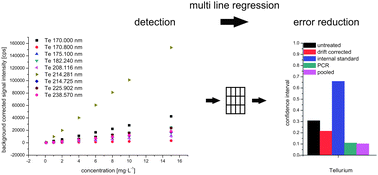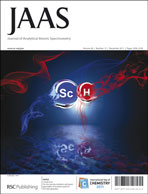In this work, an analytical procedure for determinations of the main components with inductively coupled plasma optical emission spectrometry (ICP-OES) in the case of thermoelectric materials is described, which is used to optimize the production of electrochemically deposited thermoelectric films on the basis of Bi2Te3 and Sb2Te3. To correct for flicker noise caused signal fluctuations or drifts the use of internal and external standards is evaluated. When the precision cannot be improved by their application the simultaneous detection of several emission lines of one element allows the correction for statistical noise. With principal component regression (PCR) and pooled regression, the reduction of statistical noise is demonstrated. It will be shown that in average a lowering of the limits of quantification (LOQ) and even more important, a reduction of error bands, namely the confidence intervals, for the given amounts of samples of as few as 0.1 mg down to the 1% level can be achieved.

You have access to this article
 Please wait while we load your content...
Something went wrong. Try again?
Please wait while we load your content...
Something went wrong. Try again?


 Please wait while we load your content...
Please wait while we load your content...